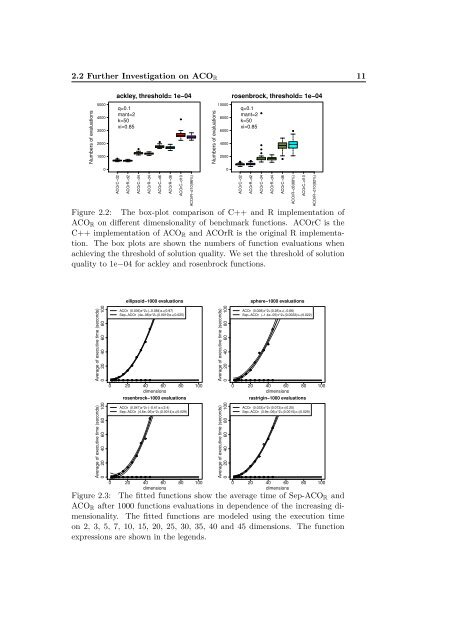Improved ant colony optimization algorithms for continuous ... - CoDE
Improved ant colony optimization algorithms for continuous ... - CoDE
Improved ant colony optimization algorithms for continuous ... - CoDE
You also want an ePaper? Increase the reach of your titles
YUMPU automatically turns print PDFs into web optimized ePapers that Google loves.
2.2 Further Investigation on ACOR<br />
Numbers of evaluations<br />
5000<br />
4000<br />
3000<br />
2000<br />
1000<br />
0<br />
ackley, threshold= 1e−04<br />
q=0.1<br />
m<strong>ant</strong>=2<br />
k=50<br />
xi=0.85<br />
ACOrC−d2<br />
ACOrR−d2<br />
ACOrC−d4<br />
ACOrR−d4<br />
ACOrC−d6<br />
ACOrR−d6<br />
ACOrC−d10<br />
ACOrR−d10(96%)<br />
Numbers of evaluations<br />
10000<br />
8000<br />
6000<br />
4000<br />
2000<br />
0<br />
rosenbrock, threshold= 1e−04<br />
q=0.1<br />
m<strong>ant</strong>=2<br />
k=50<br />
xi=0.85<br />
Figure 2.2: The box-plot comparison of C++ and R implementation of<br />
ACOR on different dimensionality of benchmark functions. ACOrC is the<br />
C++ implementation of ACOR and ACOrR is the original R implementation.<br />
The box plots are shown the numbers of function evaluations when<br />
achieving the threshold of solution quality. We set the threshold of solution<br />
quality to 1e−04 <strong>for</strong> ackley and rosenbrock functions.<br />
Average of executive time (seconds)<br />
0 20 40 60 80 100<br />
Average of executive time (seconds)<br />
0 20 40 60 80 100<br />
ellipsoid−1000 evaluations<br />
ACOr (0.036)x^2+(−0.084)x+(0.97)<br />
Sep−ACOr (4e−08)x^2+(0.0019)x+(0.025)<br />
0 20 40 60 80 100<br />
dimensions<br />
rosenbrock−1000 evaluations<br />
ACOr (0.047)x^2+(−0.41)x+(2.4)<br />
Sep−ACOr (4.6e−06)x^2+(0.0014)x+(0.029)<br />
0 20 40 60 80 100<br />
dimensions<br />
Average of executive time (seconds)<br />
0 20 40 60 80 100<br />
Average of executive time (seconds)<br />
0 20 40 60 80 100<br />
ACOrC−d2<br />
ACOrR−d2<br />
ACOrC−d4<br />
ACOrR−d4<br />
ACOrC−d6<br />
ACOrR−d6(88%)<br />
ACOrC−d10<br />
sphere−1000 evaluations<br />
ACOr (0.028)x^2+(0.28)x+(−0.66)<br />
Sep−ACOr (−1.4e−05)x^2+(0.0022)x+(0.022)<br />
ACOrR−d10(92%)<br />
0 20 40 60 80 100<br />
dimensions<br />
rastrigin−1000 evaluations<br />
ACOr (0.033)x^2+(0.073)x+(0.25)<br />
Sep−ACOr (3.9e−06)x^2+(0.0015)x+(0.029)<br />
0 20 40 60 80 100<br />
dimensions<br />
Figure 2.3: The fitted functions show the average time of Sep-ACOR and<br />
ACOR after 1000 functions evaluations in dependence of the increasing dimensionality.<br />
The fitted functions are modeled using the execution time<br />
on 2, 3, 5, 7, 10, 15, 20, 25, 30, 35, 40 and 45 dimensions. The function<br />
expressions are shown in the legends.<br />
11

















